The moon is firmly in China’s grip. In the past few years, China has successfully mastered four landings on the Earth’s satellite. The United States actually wanted to do the same now – but they failed even before liftoff, as Joern Petring reports.
Meanwhile, Beijing is not quite as successful on planet Earth: The project volume of the New Silk Road is shrinking. Moreover, China is increasingly withdrawing from financing and letting other donors take the lead. This is shown by an analysis by Germany Trade & Invest (GTAI), which Finn Mayer-Kuckuk was able to see in advance. It reveals that the Belt and Road Initiative wants to become smaller but more refined.
The leadership in Beijing has never shied away from using animal analogies to illustrate its point. Johnny Erling presents another animal today: the gazelle. Nimble and agile, it is now supposed to give China’s economy a head start.

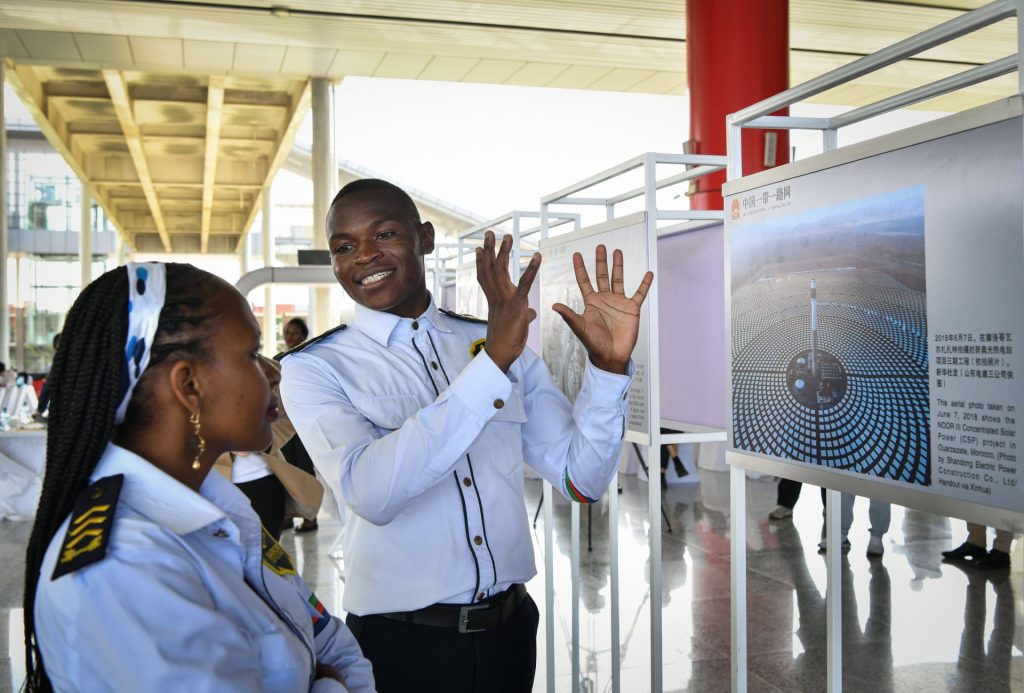
The projects volume of the new Silk Road is declining. Moreover, China is increasingly withdrawing from financing and allowing other donors to take the lead. This is the result of the latest data analysis on Silk Road activities carried out by Germany Trade & Invest (GTAI).
The number of projects mainly remained constant at 513 in the first half of 2024 compared to 529 in the same period of the previous year. However, according to GTAI, there is a trend towards smaller projects with an order volume of less than 100 million US dollars. “According to Beijing, the projects will not only be ‘smarter’ and ‘prettier,’ but above all ‘smaller,’” says regional GTAI expert Marcus Hernig. In October 2023, President Xi Jinping announced a change of course in this direction.
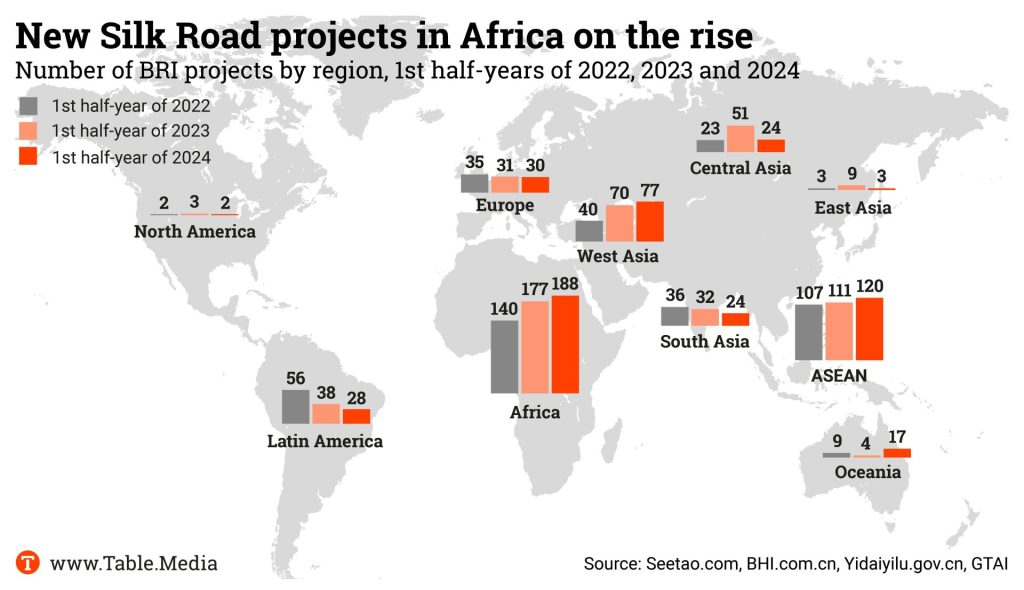
This perception increased even more during 2024: The proportion of comparatively small Belt and Road Initiative (BRI) investments continued to rise. It increased from 40 to 72 from the first to the second quarter.
The reasons for the shift towards modesty:
Instead of deep-sea ports, China now builds smaller facilities that directly benefit the population. GTAI cites the following examples:

The new focus is on very underdeveloped African regions, where a water pipeline or a hospital can make a big difference. On the other hand, the number of projects in Latin America has declined. However, it may pick up again soon in South America: In July 2024, Brazil decided to join the BRI.
In parallel, the two-year trend of less and less money from China’s state banks and more from other lenders such as the World Bank, the Asian Infrastructure Investment Bank (AIIB) and the German development bank KfW continued.
From the outset, China has sought to set the framework for infrastructure development with the BRI without having to foot the bill for everything in the end. By reducing the number of projects, the shift towards international investors now appears to be making progress. GTAI statistics include declarations of intent, new contracts, and follow-up contracts.

In another setback for the United States in the space race against China, NASA has canceled its rover mission VIPER. The plan was to send VIPER to the far side of the moon with a spacecraft from Pittsburgh-based start-up Astrobotic. However, Astrobotic failed in its first landing attempt at the start of the year. The next mission, which was to have Viper on board, has been postponed until at least 2025. Although NASA has already invested around 450 million dollars in the rover, it has now decided not to wait any longer for cost reasons.
“Continuation of VIPER would result in an increased cost that threatens cancellation or disruption to other CLPS missions. NASA has notified Congress of the agency’s intent,” NASA explained in a press release in July. Instead, NASA now wants to use “alternative methods” to verify the presence of ice at the moon’s south pole.
This represents the latest embarrassing incident in NASA’s efforts to return to the moon. NASA has not used any vehicles on the lunar surface since the Apollo astronauts’ moon buggies. Instead, the moon has been firmly in Chinese hands for years. Since 2013, the People’s Republic has already successfully completed four landing missions. All of them went according to plan:
The Chinese dominance is a disgrace for VIPER fans. However, supporters of the project are not ready to give up. By 30 July, more than 4,400 people had signed an open letter to the US Congress. In it, they call on MPs to stop NASA’s decision to cancel the program and continue funding it.
On 25 July, a Senate subcommittee presented its proposal for NASA funding. However, it only provides for a tiny increase of 30 million dollars for lunar research purposes. And it is considered unlikely that any of this will go to VIPER. There were immediate calls for the additional funding to be channeled into the Artemis program instead.
Artemis is the United States’ lunar program, which aims to bring astronauts back to the moon. But here, too, things are anything but going according to plan. The first unmanned test flight of the new rocket only took place in November 2022 after several delays.
A manned test flight was actually scheduled for this year, but due to technical issues, it has been postponed until September 2025 at the earliest. As a result, the original date for the moon landing in December 2025 cannot be met. Some experts already doubt whether it will even be possible in 2026.
If the United States’ problems continue, it would not be surprising if the Chinese eventually get people to the moon faster. Their official plans aim to send a team of astronauts to the moon by 2030. The reliable rover program shows that no significant delays are to be expected in the manned lunar program either.
Meanwhile, it might be some consolation to the USA that the lunar plans of other countries are not faring any better. Several lunar probes from India, Israel, Japan and Russia recently failed to reach their destinations.
August, 15, 2024; 9 a.m. CEST (3 p.m. Beijing time)
AHK Greater China, Guangzhou Office and Online: GCC Knowledge Hub: Enterprise Group Insurance More
The United States overtook China as Germany’s biggest trading partner in the first half of 2024. German goods trade with the USA totaled around 127 billion euros from January to June, while exports and imports with the People’s Republic came to just under 122 billion euros. This is according to calculations by the news agency Reuters based on preliminary data from the German Federal Statistical Office. In 2023, the People’s Republic was Germany’s leading foreign trade partner for the eighth consecutive year with a trade volume of around 253 billion euros – but only slightly ahead of the USA by a few hundred million euros.
According to Lola Machleid, foreign trade expert at the German Chamber of Industry and Commerce (DIHK), the US has now overtaken China in terms of total trade volume, i.e., the sum of imports and exports, in the first half of the year. “Due to the resilient US economy, exports to the United States have increased.” Overall, German exports to the US increased by 3.3 percent to almost 81 billion euros in the six months, while business with China shrank by almost 3 percent to just over 48 billion euros.
Imports from China fell by almost 8 percent to 73.5 billion euros. “In view of the current geopolitical uncertainties and the uncertain further economic development, not only in the US and China, but also here in Germany, it is difficult to predict how the neck-and-neck race will continue to develop,” said Machleid. rtr
China’s carbon emissions fell by one percent in the second quarter. According to China expert Lauri Myllyvirta from the Centre for Research on Energy and Clean Air, this is the first quarterly decline since the end of zero-Covid. This policy had significantly curbed China’s production activities for a long time; since then, the economy has been gradually recovering, which has also caused emissions to rise again. Official figures and economic data indicate that China will also emit less CO2 in 2024 than in 2023, writes Myllyvirta in an article for the specialist service Carbon Brief.
Officially, China does not aim to reach the emissions peak until 2030 – however, experts hope for an earlier decline. Myllyvirta’s article points to a number of indicators. For example, electricity generation from wind and solar energy increased by 171 terawatt hours (TWh) in the first half of the year, which is more than the UK’s total electricity generation in the first half of 2023. The increasing number of electric cars on the roads reduced the demand for gasoline. Furthermore, carbon emissions from energy use and cement production both dropped by one percent in the second quarter after a sharp rise in January and February.
China’s energy consumption continues to rise due to the growing economy, while carbon emissions per unit of GDP are improving. However, according to Myllyvirta, the efficiency improvement fell short of Beijing’s targets in the first quarter. Yet there are signs of a paradigm shift: China plans to set a hard emissions cap instead of efficiency targets for the first time. The State Council presented a corresponding work program at the end of last week. ck
Sales of New Energy Vehicles (NEVs) in China increased by 37 percent in July compared to the same month last year, reaching a record share of 50.7 percent of car sales. This is according to new data from the China Passenger Car Association. However, overall car sales in the Chinese market decreased by 3.1 percent, continuing the decline for the fourth consecutive month. One of the reasons for the weak consumer confidence is the ongoing crisis in the property sector.
Weakness in the auto market prompted China’s state planning agency to announce in late July that cash subsidies for vehicle purchases would be doubled – up to 20,000 yuan (2,785 US dollars) per purchase – and would be retroactive to April when the subsidies were first introduced.
Additionally, some cities with curbs on car purchases have moved to relax restrictions. The capital city Beijing, for instance, announced last month it would offer to expand its NEV license quota by 20,000, the first easing of curbs since a strict quota system was put in place in 2011 to ease traffic congestion and improve air quality. rtr
British Airways will suspend its route from London to Beijing for the time being. The route will be paused from October 26, the British airline informed the industry platform Head for Points on Thursday. The change will be implemented at the end of the summer flight schedule. The airline said all affected passengers will be contacted and offered rebooking options or refunds. “We continue to operate daily flights to Shanghai and Hong Kong,” the company told Head for Points.
British Airways did not provide an explanation for the temporary suspension. The airline had already suspended the route in 2020 due to the COVID-19 pandemic and resumed it in June 2023. BA is not the only airline that has reduced its China routes: Last month, Virgin Atlantic announced it was pulling out of Shanghai – its only flight to East Asia. Australian airline Qantas has also left mainland China after indicating flights were only “half full.”
Things are different in Hungary: The first direct flight from Shenzhen landed in Budapest last week. “With the launch of the Hainan Airlines’ Shenzhen-Budapest direct flight route, the number of direct flights between Budapest and major Chinese cities has increased to seven, and the number of direct passenger flights between China and Hungary has reached 21 per week,” said Gong Tao, Chinese Ambassador to Hungary, at the opening ceremony. The Budapest-Shenzhen route will operate two flights per week. ari

Party leader Xi Jinping summoned the members of his Politburo in Beijing at the end of July, one day before the start of their two-week summer break. He demanded that his highest-ranking officials bring the ailing economy back on its feet right after their vacation. To this end, they would have to promote “modern high-tech and future-oriented industries,” introduce a “mechanism in the market” that “pushes out backward and inefficient production” (畅通落后低效产能退出渠道) and “allows only the fittest to survive.” (要 … 强化市场优胜劣汰机制). The Politburo should also “strongly and effectively support gazelle and unicorn companies” (要有力有效支持发展瞪羚企业、独角兽企业).
These strange animal names stand for private high-tech and IT start-ups. They represent tens of thousands of fast-growing start-ups (gazelles) and corporations worth billions (unicorns) planning their IPO.
Weary of the stereotypical reform babble that the Communist Party has been spinning in the media since its Third Central Committee Plenum, most observers missed Xi’s latest proposal. Hong Kong’s South China Morning Post (SCMP) noted with astonishment that Beijing is not only banking on gazelles and unicorns, but is also introducing the jungle principle of “survival of the fittest” into its socialist market economy. The SCMP quipped, “China’s business environment is beginning to sound like the African Savannah.” Beijing probably hopes that the gazelles and unicorns will provide new impetus for innovation, high-quality development and more employment, which China’s ailing economy so desperately needs.
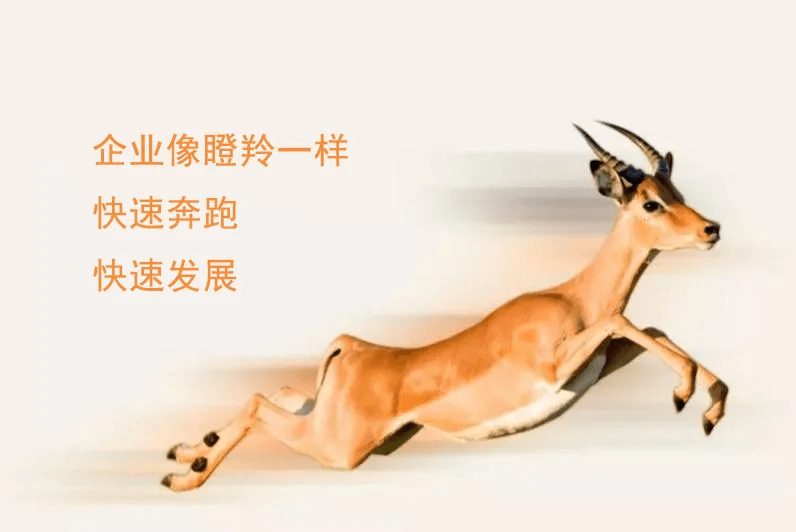
China is familiar with excursions into the animal kingdom from the speeches of its party leader. As soon as he took office, Xi launched a twelve-year anti-corruption campaign. His battle cry was: Slapping tigers 打老虎 (cracking down on high-ranking officials), swatting flies 拍苍蝇 (going after minor officials), and catching foxes 猎狐 (bringing back those who fled abroad with embezzled assets). Xi also disposed of numerous political opponents during his campaign.
Gazelle and unicorn are new terms in his repertoire. Ever since the Politburo has had to deal with exotic hoofed animals, the state press and social media have rushed to interpret them. Websites such as Cyber-Finance 赛博财经 rely on artificial intelligence (AI) to do this. With success: on August 3, it explained thanks to ChatGPT: 摘要由作者通过智能技术生成 “Gazelles are the term used for very fast-growing, innovative start-ups. They are concentrated in metropolitan areas such as Beijing and Guangdong and invest primarily in sectors such as new-generation information technologies. “Gazelles later become unicorns.” ChatGPT added: “Political support is crucial to their development.” 政策扶持对瞪羚企业发展至关重要
It’s a good thing the AI didn’t also reveal that it was Xi who reined in high-tech start-ups a few years ago that had become too politically independent for his liking. To set an example, he politically clipped the wings of the most successful former unicorn company and e-commerce giant Alibaba and its founder Jack Ma.
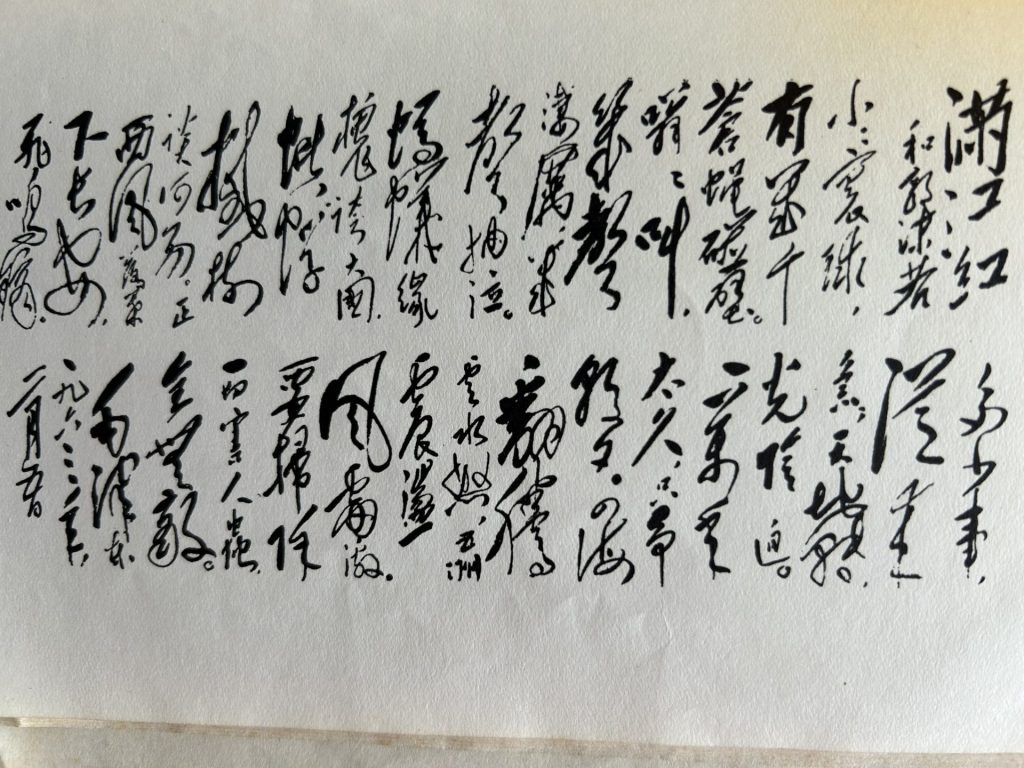
Xi, who prefers to have the Party guide the economy from the top down instead of helping the market principle achieve a breakthrough, needs private start-ups to steer China on a course of high-tech development. In the next six months, the Politburo wants to provide special funding for all companies that qualify for gazelle or unicorn status, wrote the financial policy magazine Caixin. It expects Beijing to soon issue directives on how it will support them in going public and raising funds.
The term “gazelle company” originated in the United States and goes back to MIT economist David Birch and his 1987 book “Job Creation in America.” Following his studies in Silicon Valley, he described local start-ups as “small, fast and high-jumping companies” with high growth rates and innovative strength that create jobs and go public. He saw them mainly in the technology and IT sectors and the retail, textile and food sectors. In 2012, the German Federal Ministry of Economics and Technology commissioned an in-depth study into gazelle companies.
The global start-up boom finally brought unicorns and gazelles to the People’s Republic. A financial analysis presented at a Beijing forum in April by consulting firms such as KPMG, ZGC-Unicorn Alliance and Great Wall Enterprise named China the second-largest home for gazelles and unicorns after the USA in 2024. Although their numbers dwindled for some time due to the Party’s interventionist policies, they are now making headway, particularly in artificial intelligence and semiconductor development. The study lists 369 Chinese unicorns (the USA counts 700), which are registered with an average valuation of 3.8 billion US dollars.
Now, Xi is allowing gazelles and unicorns (and their entrepreneurs) to be embraced again. It is an about-turn. Just two weeks ago, he had warned his Central Committee about entirely different critters, about dangerous “gray rhinos” 灰犀牛 (long-standing unresolved problems that suddenly explode) and “black swans” 黑天鹅 (unexpectedly erupting crises). In a statement at the Third Plenum on deepening reforms, he urged the Central Committee to always first think about possible risks. “Incidents involving ‘black swans’ or ‘gray rhinos’ could occur at any time.”
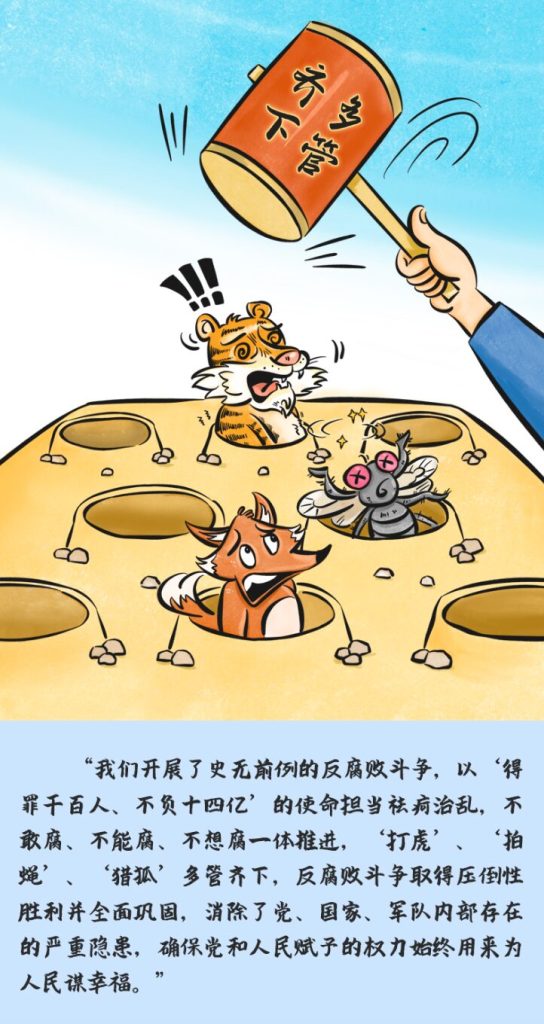
Sole ruler Xi often quotes animal symbol names, even when traveling abroad. In a Paris speech marking 50 years of diplomatic relations at the end of March 2014, he promised the people of France that they need not fear the People’s Republic: “This lion has already woken, but it is a peaceful, friendly and civilized lion.” He alluded to a saying by Napoleon, who pointed to his globe in 1803 and allegedly proclaimed: “There lies a sleeping giant. Let him sleep, for when he wakes, he will move the world.”
When he visited India in 2014, he also wooed Prime Minister Narendra Modi: “The Chinese ‘dragon’ and the Indian ‘elephant’ must not fight each other, but dance with each other.” Today, Xi is cuddling Russia’s bears when it comes to the new world order.
His predecessor Mao used animal symbols much more sparingly in his public speeches or everyday political discourse, except for his remark that the USA was a “paper tiger” and his absurd campaign in the 1950s to eradicate the four pests (rats, bugs, mosquitoes, and sparrows). Mao only later replaced the useful sparrows with cockroaches.
In contrast, numerous animals and birds, dragons and other beasts, phoenixes, fish and turtles, or golden magic monkeys like Sun Wukong populate his poems. He caricatured opponents with animal comparisons or glorified China by comparing it to mythical creatures. Dedicated Chinese studies examine and interpret which animals Mao included in his poems and why.
Such a dictionary of meanings for the animal terms Xi uses conspicuously often has yet to be written. Instead, there is one 1945 novel that helps us understand the People’s Republic, which was only founded in 1949, especially since it has been under Xi’s rule. It was actually published as a parable on the history of the Soviet Union and has an entirely different focus on animals: George Orwell’s “Animal Farm.”
Lei Feng has been Head of CIB China Market at Banque Internationale à Luxembourg (BIL) since July. Lei has 20 years of experience in corporate and investment banking and has led and participated in numerous Sino-European syndicated, project and M&A financings. Until July, he was a corporate banking expert at China Merchants Bank, also in Luxembourg.
Is something changing in your organization? Let us know at heads@table.media!
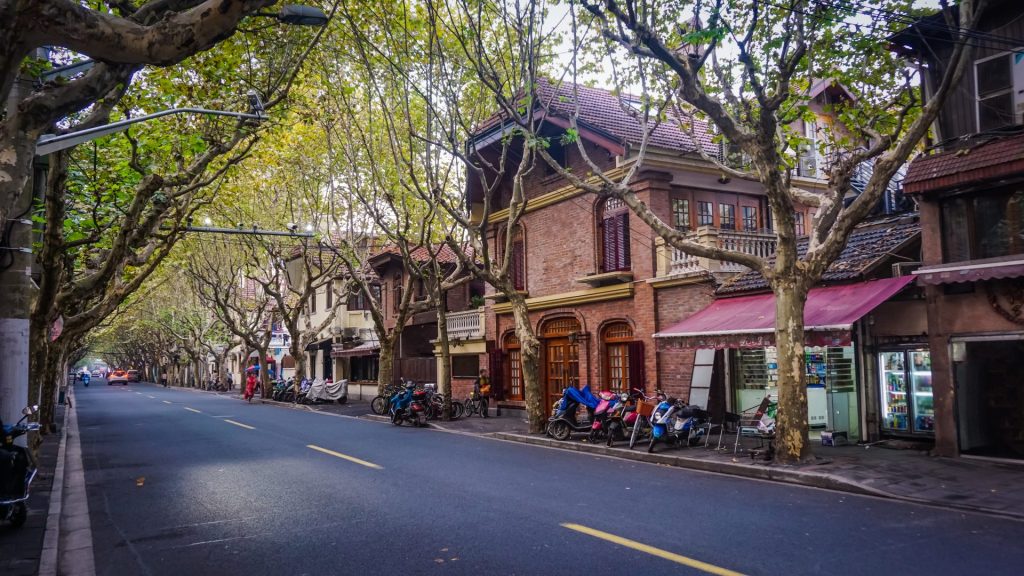
Shanghai’s Changle Lu, roughly translated as “Street of Eternal Happiness,” has always been one of the most popular streets for Chinese hipsters and expats with its run-down charm and many cafés, bars and fashion stores. However, many of the slightly crooked houses in the former French Concession have been cleared for demolition in recent weeks. The area will be given a new look. This is a development that is otherwise mainly known from Beijing, where the Sanlitun nightlife district has recently undergone luxury redevelopment.
The moon is firmly in China’s grip. In the past few years, China has successfully mastered four landings on the Earth’s satellite. The United States actually wanted to do the same now – but they failed even before liftoff, as Joern Petring reports.
Meanwhile, Beijing is not quite as successful on planet Earth: The project volume of the New Silk Road is shrinking. Moreover, China is increasingly withdrawing from financing and letting other donors take the lead. This is shown by an analysis by Germany Trade & Invest (GTAI), which Finn Mayer-Kuckuk was able to see in advance. It reveals that the Belt and Road Initiative wants to become smaller but more refined.
The leadership in Beijing has never shied away from using animal analogies to illustrate its point. Johnny Erling presents another animal today: the gazelle. Nimble and agile, it is now supposed to give China’s economy a head start.


The projects volume of the new Silk Road is declining. Moreover, China is increasingly withdrawing from financing and allowing other donors to take the lead. This is the result of the latest data analysis on Silk Road activities carried out by Germany Trade & Invest (GTAI).
The number of projects mainly remained constant at 513 in the first half of 2024 compared to 529 in the same period of the previous year. However, according to GTAI, there is a trend towards smaller projects with an order volume of less than 100 million US dollars. “According to Beijing, the projects will not only be ‘smarter’ and ‘prettier,’ but above all ‘smaller,’” says regional GTAI expert Marcus Hernig. In October 2023, President Xi Jinping announced a change of course in this direction.

This perception increased even more during 2024: The proportion of comparatively small Belt and Road Initiative (BRI) investments continued to rise. It increased from 40 to 72 from the first to the second quarter.
The reasons for the shift towards modesty:
Instead of deep-sea ports, China now builds smaller facilities that directly benefit the population. GTAI cites the following examples:

The new focus is on very underdeveloped African regions, where a water pipeline or a hospital can make a big difference. On the other hand, the number of projects in Latin America has declined. However, it may pick up again soon in South America: In July 2024, Brazil decided to join the BRI.
In parallel, the two-year trend of less and less money from China’s state banks and more from other lenders such as the World Bank, the Asian Infrastructure Investment Bank (AIIB) and the German development bank KfW continued.
From the outset, China has sought to set the framework for infrastructure development with the BRI without having to foot the bill for everything in the end. By reducing the number of projects, the shift towards international investors now appears to be making progress. GTAI statistics include declarations of intent, new contracts, and follow-up contracts.

In another setback for the United States in the space race against China, NASA has canceled its rover mission VIPER. The plan was to send VIPER to the far side of the moon with a spacecraft from Pittsburgh-based start-up Astrobotic. However, Astrobotic failed in its first landing attempt at the start of the year. The next mission, which was to have Viper on board, has been postponed until at least 2025. Although NASA has already invested around 450 million dollars in the rover, it has now decided not to wait any longer for cost reasons.
“Continuation of VIPER would result in an increased cost that threatens cancellation or disruption to other CLPS missions. NASA has notified Congress of the agency’s intent,” NASA explained in a press release in July. Instead, NASA now wants to use “alternative methods” to verify the presence of ice at the moon’s south pole.
This represents the latest embarrassing incident in NASA’s efforts to return to the moon. NASA has not used any vehicles on the lunar surface since the Apollo astronauts’ moon buggies. Instead, the moon has been firmly in Chinese hands for years. Since 2013, the People’s Republic has already successfully completed four landing missions. All of them went according to plan:
The Chinese dominance is a disgrace for VIPER fans. However, supporters of the project are not ready to give up. By 30 July, more than 4,400 people had signed an open letter to the US Congress. In it, they call on MPs to stop NASA’s decision to cancel the program and continue funding it.
On 25 July, a Senate subcommittee presented its proposal for NASA funding. However, it only provides for a tiny increase of 30 million dollars for lunar research purposes. And it is considered unlikely that any of this will go to VIPER. There were immediate calls for the additional funding to be channeled into the Artemis program instead.
Artemis is the United States’ lunar program, which aims to bring astronauts back to the moon. But here, too, things are anything but going according to plan. The first unmanned test flight of the new rocket only took place in November 2022 after several delays.
A manned test flight was actually scheduled for this year, but due to technical issues, it has been postponed until September 2025 at the earliest. As a result, the original date for the moon landing in December 2025 cannot be met. Some experts already doubt whether it will even be possible in 2026.
If the United States’ problems continue, it would not be surprising if the Chinese eventually get people to the moon faster. Their official plans aim to send a team of astronauts to the moon by 2030. The reliable rover program shows that no significant delays are to be expected in the manned lunar program either.
Meanwhile, it might be some consolation to the USA that the lunar plans of other countries are not faring any better. Several lunar probes from India, Israel, Japan and Russia recently failed to reach their destinations.
August, 15, 2024; 9 a.m. CEST (3 p.m. Beijing time)
AHK Greater China, Guangzhou Office and Online: GCC Knowledge Hub: Enterprise Group Insurance More
The United States overtook China as Germany’s biggest trading partner in the first half of 2024. German goods trade with the USA totaled around 127 billion euros from January to June, while exports and imports with the People’s Republic came to just under 122 billion euros. This is according to calculations by the news agency Reuters based on preliminary data from the German Federal Statistical Office. In 2023, the People’s Republic was Germany’s leading foreign trade partner for the eighth consecutive year with a trade volume of around 253 billion euros – but only slightly ahead of the USA by a few hundred million euros.
According to Lola Machleid, foreign trade expert at the German Chamber of Industry and Commerce (DIHK), the US has now overtaken China in terms of total trade volume, i.e., the sum of imports and exports, in the first half of the year. “Due to the resilient US economy, exports to the United States have increased.” Overall, German exports to the US increased by 3.3 percent to almost 81 billion euros in the six months, while business with China shrank by almost 3 percent to just over 48 billion euros.
Imports from China fell by almost 8 percent to 73.5 billion euros. “In view of the current geopolitical uncertainties and the uncertain further economic development, not only in the US and China, but also here in Germany, it is difficult to predict how the neck-and-neck race will continue to develop,” said Machleid. rtr
China’s carbon emissions fell by one percent in the second quarter. According to China expert Lauri Myllyvirta from the Centre for Research on Energy and Clean Air, this is the first quarterly decline since the end of zero-Covid. This policy had significantly curbed China’s production activities for a long time; since then, the economy has been gradually recovering, which has also caused emissions to rise again. Official figures and economic data indicate that China will also emit less CO2 in 2024 than in 2023, writes Myllyvirta in an article for the specialist service Carbon Brief.
Officially, China does not aim to reach the emissions peak until 2030 – however, experts hope for an earlier decline. Myllyvirta’s article points to a number of indicators. For example, electricity generation from wind and solar energy increased by 171 terawatt hours (TWh) in the first half of the year, which is more than the UK’s total electricity generation in the first half of 2023. The increasing number of electric cars on the roads reduced the demand for gasoline. Furthermore, carbon emissions from energy use and cement production both dropped by one percent in the second quarter after a sharp rise in January and February.
China’s energy consumption continues to rise due to the growing economy, while carbon emissions per unit of GDP are improving. However, according to Myllyvirta, the efficiency improvement fell short of Beijing’s targets in the first quarter. Yet there are signs of a paradigm shift: China plans to set a hard emissions cap instead of efficiency targets for the first time. The State Council presented a corresponding work program at the end of last week. ck
Sales of New Energy Vehicles (NEVs) in China increased by 37 percent in July compared to the same month last year, reaching a record share of 50.7 percent of car sales. This is according to new data from the China Passenger Car Association. However, overall car sales in the Chinese market decreased by 3.1 percent, continuing the decline for the fourth consecutive month. One of the reasons for the weak consumer confidence is the ongoing crisis in the property sector.
Weakness in the auto market prompted China’s state planning agency to announce in late July that cash subsidies for vehicle purchases would be doubled – up to 20,000 yuan (2,785 US dollars) per purchase – and would be retroactive to April when the subsidies were first introduced.
Additionally, some cities with curbs on car purchases have moved to relax restrictions. The capital city Beijing, for instance, announced last month it would offer to expand its NEV license quota by 20,000, the first easing of curbs since a strict quota system was put in place in 2011 to ease traffic congestion and improve air quality. rtr
British Airways will suspend its route from London to Beijing for the time being. The route will be paused from October 26, the British airline informed the industry platform Head for Points on Thursday. The change will be implemented at the end of the summer flight schedule. The airline said all affected passengers will be contacted and offered rebooking options or refunds. “We continue to operate daily flights to Shanghai and Hong Kong,” the company told Head for Points.
British Airways did not provide an explanation for the temporary suspension. The airline had already suspended the route in 2020 due to the COVID-19 pandemic and resumed it in June 2023. BA is not the only airline that has reduced its China routes: Last month, Virgin Atlantic announced it was pulling out of Shanghai – its only flight to East Asia. Australian airline Qantas has also left mainland China after indicating flights were only “half full.”
Things are different in Hungary: The first direct flight from Shenzhen landed in Budapest last week. “With the launch of the Hainan Airlines’ Shenzhen-Budapest direct flight route, the number of direct flights between Budapest and major Chinese cities has increased to seven, and the number of direct passenger flights between China and Hungary has reached 21 per week,” said Gong Tao, Chinese Ambassador to Hungary, at the opening ceremony. The Budapest-Shenzhen route will operate two flights per week. ari

Party leader Xi Jinping summoned the members of his Politburo in Beijing at the end of July, one day before the start of their two-week summer break. He demanded that his highest-ranking officials bring the ailing economy back on its feet right after their vacation. To this end, they would have to promote “modern high-tech and future-oriented industries,” introduce a “mechanism in the market” that “pushes out backward and inefficient production” (畅通落后低效产能退出渠道) and “allows only the fittest to survive.” (要 … 强化市场优胜劣汰机制). The Politburo should also “strongly and effectively support gazelle and unicorn companies” (要有力有效支持发展瞪羚企业、独角兽企业).
These strange animal names stand for private high-tech and IT start-ups. They represent tens of thousands of fast-growing start-ups (gazelles) and corporations worth billions (unicorns) planning their IPO.
Weary of the stereotypical reform babble that the Communist Party has been spinning in the media since its Third Central Committee Plenum, most observers missed Xi’s latest proposal. Hong Kong’s South China Morning Post (SCMP) noted with astonishment that Beijing is not only banking on gazelles and unicorns, but is also introducing the jungle principle of “survival of the fittest” into its socialist market economy. The SCMP quipped, “China’s business environment is beginning to sound like the African Savannah.” Beijing probably hopes that the gazelles and unicorns will provide new impetus for innovation, high-quality development and more employment, which China’s ailing economy so desperately needs.

China is familiar with excursions into the animal kingdom from the speeches of its party leader. As soon as he took office, Xi launched a twelve-year anti-corruption campaign. His battle cry was: Slapping tigers 打老虎 (cracking down on high-ranking officials), swatting flies 拍苍蝇 (going after minor officials), and catching foxes 猎狐 (bringing back those who fled abroad with embezzled assets). Xi also disposed of numerous political opponents during his campaign.
Gazelle and unicorn are new terms in his repertoire. Ever since the Politburo has had to deal with exotic hoofed animals, the state press and social media have rushed to interpret them. Websites such as Cyber-Finance 赛博财经 rely on artificial intelligence (AI) to do this. With success: on August 3, it explained thanks to ChatGPT: 摘要由作者通过智能技术生成 “Gazelles are the term used for very fast-growing, innovative start-ups. They are concentrated in metropolitan areas such as Beijing and Guangdong and invest primarily in sectors such as new-generation information technologies. “Gazelles later become unicorns.” ChatGPT added: “Political support is crucial to their development.” 政策扶持对瞪羚企业发展至关重要
It’s a good thing the AI didn’t also reveal that it was Xi who reined in high-tech start-ups a few years ago that had become too politically independent for his liking. To set an example, he politically clipped the wings of the most successful former unicorn company and e-commerce giant Alibaba and its founder Jack Ma.

Xi, who prefers to have the Party guide the economy from the top down instead of helping the market principle achieve a breakthrough, needs private start-ups to steer China on a course of high-tech development. In the next six months, the Politburo wants to provide special funding for all companies that qualify for gazelle or unicorn status, wrote the financial policy magazine Caixin. It expects Beijing to soon issue directives on how it will support them in going public and raising funds.
The term “gazelle company” originated in the United States and goes back to MIT economist David Birch and his 1987 book “Job Creation in America.” Following his studies in Silicon Valley, he described local start-ups as “small, fast and high-jumping companies” with high growth rates and innovative strength that create jobs and go public. He saw them mainly in the technology and IT sectors and the retail, textile and food sectors. In 2012, the German Federal Ministry of Economics and Technology commissioned an in-depth study into gazelle companies.
The global start-up boom finally brought unicorns and gazelles to the People’s Republic. A financial analysis presented at a Beijing forum in April by consulting firms such as KPMG, ZGC-Unicorn Alliance and Great Wall Enterprise named China the second-largest home for gazelles and unicorns after the USA in 2024. Although their numbers dwindled for some time due to the Party’s interventionist policies, they are now making headway, particularly in artificial intelligence and semiconductor development. The study lists 369 Chinese unicorns (the USA counts 700), which are registered with an average valuation of 3.8 billion US dollars.
Now, Xi is allowing gazelles and unicorns (and their entrepreneurs) to be embraced again. It is an about-turn. Just two weeks ago, he had warned his Central Committee about entirely different critters, about dangerous “gray rhinos” 灰犀牛 (long-standing unresolved problems that suddenly explode) and “black swans” 黑天鹅 (unexpectedly erupting crises). In a statement at the Third Plenum on deepening reforms, he urged the Central Committee to always first think about possible risks. “Incidents involving ‘black swans’ or ‘gray rhinos’ could occur at any time.”

Sole ruler Xi often quotes animal symbol names, even when traveling abroad. In a Paris speech marking 50 years of diplomatic relations at the end of March 2014, he promised the people of France that they need not fear the People’s Republic: “This lion has already woken, but it is a peaceful, friendly and civilized lion.” He alluded to a saying by Napoleon, who pointed to his globe in 1803 and allegedly proclaimed: “There lies a sleeping giant. Let him sleep, for when he wakes, he will move the world.”
When he visited India in 2014, he also wooed Prime Minister Narendra Modi: “The Chinese ‘dragon’ and the Indian ‘elephant’ must not fight each other, but dance with each other.” Today, Xi is cuddling Russia’s bears when it comes to the new world order.
His predecessor Mao used animal symbols much more sparingly in his public speeches or everyday political discourse, except for his remark that the USA was a “paper tiger” and his absurd campaign in the 1950s to eradicate the four pests (rats, bugs, mosquitoes, and sparrows). Mao only later replaced the useful sparrows with cockroaches.
In contrast, numerous animals and birds, dragons and other beasts, phoenixes, fish and turtles, or golden magic monkeys like Sun Wukong populate his poems. He caricatured opponents with animal comparisons or glorified China by comparing it to mythical creatures. Dedicated Chinese studies examine and interpret which animals Mao included in his poems and why.
Such a dictionary of meanings for the animal terms Xi uses conspicuously often has yet to be written. Instead, there is one 1945 novel that helps us understand the People’s Republic, which was only founded in 1949, especially since it has been under Xi’s rule. It was actually published as a parable on the history of the Soviet Union and has an entirely different focus on animals: George Orwell’s “Animal Farm.”
Lei Feng has been Head of CIB China Market at Banque Internationale à Luxembourg (BIL) since July. Lei has 20 years of experience in corporate and investment banking and has led and participated in numerous Sino-European syndicated, project and M&A financings. Until July, he was a corporate banking expert at China Merchants Bank, also in Luxembourg.
Is something changing in your organization? Let us know at heads@table.media!

Shanghai’s Changle Lu, roughly translated as “Street of Eternal Happiness,” has always been one of the most popular streets for Chinese hipsters and expats with its run-down charm and many cafés, bars and fashion stores. However, many of the slightly crooked houses in the former French Concession have been cleared for demolition in recent weeks. The area will be given a new look. This is a development that is otherwise mainly known from Beijing, where the Sanlitun nightlife district has recently undergone luxury redevelopment.
